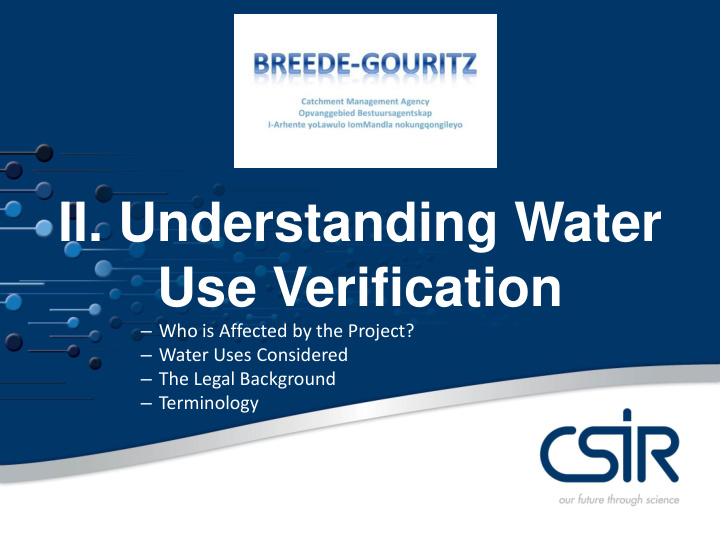



II. Understanding Water Use Verification – Who is Affected by the Project? – Water Uses Considered – The Legal Background – Terminology
Project Primary Aim / Objective To determine how much water was being lawfully used in the qualifying period?
Five Questions! • Who are you? • Where are/were you using the water? • How much water was/is being used? • What was/is it being used for? • Was/Is the use lawful?
Who is Affected by the Project? • All water users in the project area: – excluding those supplied by a municipality or water board – excluding small scale non-commercial and domestic uses • Water users that are part of an irrigation board or water user association --------------------------------------------------------------------------------------------------------------------------------------------------------------------------------------------------------- • Registered users (WARMS database) • Non-registered users • Users with existing authorisations (ELU, GA, WUL)
Water Uses Considered • s21 (a) : Water abstraction (surface & groundwater) for: – Irrigation – Water Supply – Industry • s21 (b) : Storing water (dams) • s21 (d) : Stream Flow Reduction Activity (SFRA) as a result of commercial forestry
The Legal Background • Water Act 54 of 1956 • National Water Act 36 of 1998 (NWA) – Lawful exercised uses are recognised and new use is authorised through other mechanisms in the NWA – Water use verification is described in sections 32 to 35 of the NWA Section 33 Section 35
Terminology Existing Lawful Use (ELU) – Extent of water use in the 2-year period (Qualifying Period) prior to the NWA (1998) – The use was lawful under laws in place during the Qualifying Period – The NWA allows users to continue with their existing water use , subject to the original conditions and limitations, until such time that this authorisation is replaced by a water use licence .
Terminology EXISTING LAWFUL authorised under any law that has taken place any in place before date of time during 2 years + commencement of the before commencement of Act the Act “took place lawfully” “ qualifying period ” Surface Water Groundwater 1 October 1997 to 1 October 1996 to 30 September 1999 30 September 1998
Terminology Existing Lawful Use is determined through Validation & Verification – Validation : a technical process to determine the extent of water uses during the qualifying period. – Verification : a legal process to determine the lawfulness of water used under any law prior to the National Water Act of 1998 .
Terminology Water Use Registration • A requirement of the NWA – from 2000 • Basis for water management information & to levy water use charges • NOT an entitlement to use water: An indication by the user of the extent of water use that would be subject to validation & verification • All existing and new water use falls within the requirements of the NWA
Misconceptions Regarding Registration • Registration is a “licence”/ water use entitlement • If I pay for my registered water use, it is an entitlement • Non-registration affects “Existing Lawful Use ” A Registration Certificate does not mean a water use is lawful and is not an acknowledgement of a water use entitlement
High-Level Water Management Process Flow: Water Allocation Reform Irrigation & Cadastral and IWAAS SFRA Modelling Validate Water Deeds Office Project and Land-Cover Data Data Classification Input Use (s35) Validation Database Verification Determination of the WARMS and Data Gaps Data Legality of Water Use Mapbook Legal Database and Files Catchment Stakeholder Management Strategy Verify Water Use Engagement & (incl ELU (s32-35), (Water Allocation Plan) Public Licences & GA) (s9 (e )) Participation Validation & Verification Licensing (s40-42) / Project Tasks General Review Compulsory of Licences (s49) Licensing (s43-48)
The V&V Project Context ….. South Africa is a dry, water-stressed country that has strived to adopt a rational, just and equitable way to manage this limited resource since achieving democracy – to achieve its This project is the starting point of South Africa’s Water Allocation socio-economic development goals and ensure its sustainability Reform process and provides an important basis for all strategic The previous water law, based on the Roman and Dutch riparian rights principle , gave access Integrated Water Resource Management (IWRM) activities to the resource to those who owned land. The minority white population (3%) owned approximately 87% of the land and controlled the rights to water resources Although the riparian rights principle and the concepts of public and private water have been abolished, their legacy still endures and all lawful water use in terms of these and other relevant statutes are recognised by the current National Water Act (NWA) WAR and Water Use Validation & Verification is unique to The current emphasis on consumptive use of water by irrigated agriculture is that use by this South Africa ; sector accounts for approximately 62 percent of the water use in South Africa, and makes a relatively small contribution to South Africa’s gross domestic product (primary agriculture ~ there is no other comparable project approach / footprint 4%) internationally
Recommend
More recommend